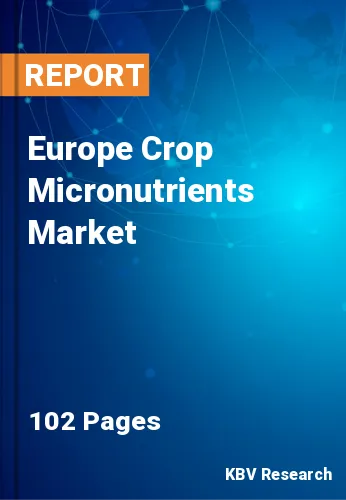The Europe Crop Micronutrients Market would witness market growth of 6.8% CAGR during the forecast period (2022-2028).
Visual signs on crops, as well as soil and plant tissue testing, can be used to detect micronutrient deficiencies. Knowing the role of each vitamin in plant growth and development helps understand visual symptoms. Due to variations in soil aspects, which influence availability and management history, micronutrient deficiencies frequently have a scattered distribution in fields. Recognizing problematic regions and planning rehabilitation for future crops requires the ability to visually recognize shortcomings.
Maintaining better field records would help farmers know which fields have had suspected or proven micronutrient deficiencies; do annual soil tests, and keep track of each crop's symptoms. The quantity of micronutrients required varies depending on the crop. To enable site-specific management easier, georeference micronutrient deficient spots within a field.
The expansion of the agricultural sector in various nations of the region is one of the key drivers fueling the growth of the regional crop micronutrients market over the forecast period. The partnership between Farm advisory services and European Innovation makes it possible to promote the adoption of new technology, new management approaches that are tailored to local conditions, and custom-made solutions. Farmers can be reimbursed for professional advice as well as the knowledge and information needed to carry out farm operations if Member States program the advisory measure.
For example, when the cross-compliance mechanism underneath the CAP payments was introduced, the financing for advising services under Article 15 aided farmers. Cross-compliance ties CAP subsidies to farmers' compliance with EU rules on the environment, food safety, public, animal, and plant health, animal welfare, and keeping land in excellent agricultural and environmental condition (GAEC). Owing to these rules and regulations as well as government support, the demand, and growth of the regional crop micronutrients market in the coming years.
The Germany market dominated the Europe Crop Micronutrients Market by Country in 2021, and would continue to be a dominant market till 2028; thereby, achieving a market value of $409.8 million by 2028. The UK market is anticipated to grow at a CAGR of 5.9% during (2022 - 2028). Additionally, The France market would showcase a CAGR of 7.6% during (2022 - 2028).
Based on Form, the market is segmented into Chelated and Non-Chelated. Based on Application, the market is segmented into Soil, Foliar, Fertigation, and Others. Based on Crop Type, the market is segmented into Cereals & Grains, Pulses & Oilseeds, Fruits & Vegetables, and Others. Based on Type, the market is segmented into Copper, Zinc, Boron, Iron, Manganese, Molybdenum, and Others. Based on countries, the market is segmented into Germany, UK, France, Russia, Spain, Italy, and Rest of Europe.
Free Valuable Insights: The Global Crop Micronutrients Market Size will Hit $8.7 Billion by 2028, at a CAGR of 7.5%
The market research report covers the analysis of key stake holders of the market. Key companies profiled in the report include BASF SE, Compass Minerals International, Inc., The Mosaic Company, Nutrien Limited, DuPont de Nemours, Inc., Akzo Nobel N.V., Aries Agro Limited, Yara International ASA, Baicor, LLC, and Western Nutrients Corporation.
By Form
By Application
By Crop Type
By Type
By Country
Our team of dedicated experts can provide you with attractive expansion opportunities for your business.

